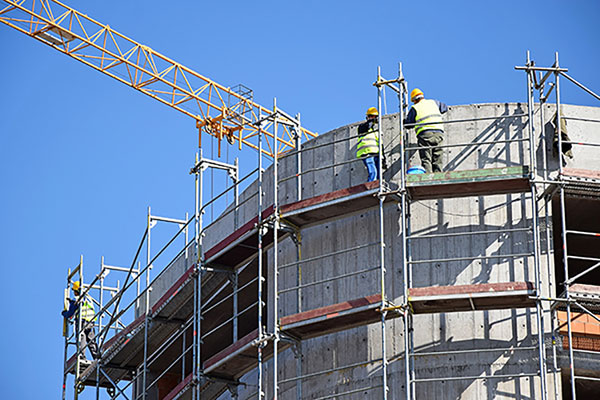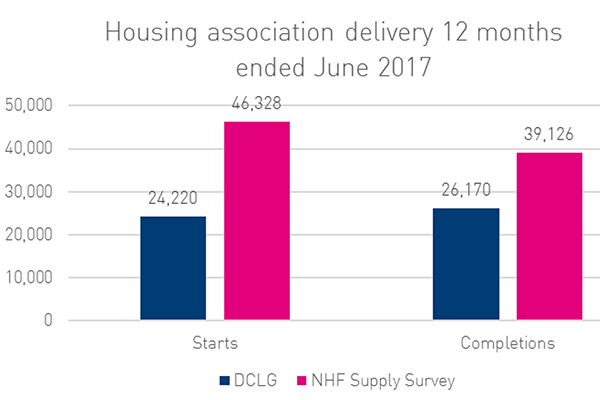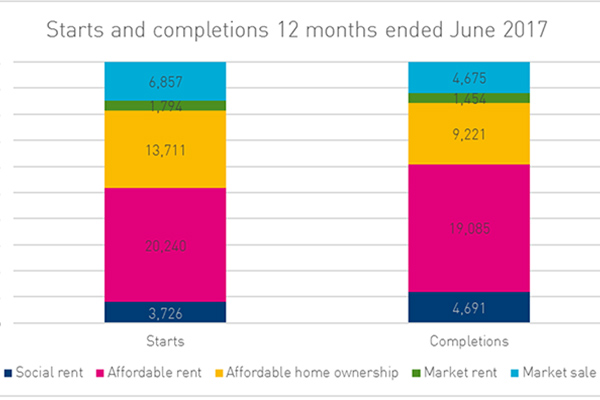You are viewing 1 of your 1 free articles
Painting a truer picture of association development
The National Housing Federation is seeking to tackle underestimates of association development in official figures. Jenny Charlton explains how
Every quarter we survey our developing members to build a picture of the number of much-needed new homes the sector delivers.
The survey, which we started in March 2016, gives us a richer understanding of this important issue.
This quarter, 205 housing associations responded to our survey, representing 94% of stock owned by developing housing associations.
Before we delve into the results, it’s important to outline why we started running this survey, given the mind-boggling number of other data sources already available.
Some of those data sources – Homes and Communities Agency and Greater London Authority figures – only capture programme-funded activity.
This overlooks the large number of homes that housing associations deliver without government investment. Indeed, our survey shows that in this quarter 61% of starts and 48% of completions were funded outside the Affordable Homes Programme.
Elsewhere, while the Department for Communities and Local Government’s (DCLG) data on housing association delivery has a number of strengths – not least its completions data, which goes back to 1946 – the tenure split used has its limitations and is not the best source of information on new build affordable housing.
“Some data sources – the Homes and Communities Agency and Greater London Authority figures – only capture programme-funded activity.”
This is primarily because DCLG attributes some homes built under Section 106 agreements to the private sector, despite these homes being acquired and owned by the housing association sector.
This leads to significant under-reporting of the fantastic work our members do to provide new homes to people across the country.
That’s why we have decided to start telling our own stories. In contrast to other data sources, our survey counts all homes that were commissioned by, procured by, funded by and (ultimately) owned by housing associations.
Yesterday DCLG released its quarterly data, showing that 7,200 homes were completed by housing associations between April and June this year. Our members reported 9,291 homes.
While this is a significant difference, it is important not to get too focused on a single quarter (in part because DCLG’s data is seasonally adjusted, whereas ours is not).
Instead the following chart demonstrates the difference between the two datasets over the 12-month period up to June 2017. Our members reported a staggering additional 13,000 completions compared to the DCLG.
In addition to these top-line numbers, the survey provides information down to a local authority level – by tenure, number of homes delivered through Section 106, and development in rural areas.
“Despite a number of challenges ranging from rent cuts to grant funding to the availability of land, housing associations continue to provide new homes.”
The following chart turns our attention to tenure.
Unsurprisingly, given previous grant regimes, the majority of development is affordable rent and shared ownership (28,300 completions).
However, a significant number are also social rent (4,700 completions), showing that housing associations are determined to continue providing this much-needed tenure despite a lack of grant funding.
These results demonstrate that, despite a number of challenges ranging from rent cuts to grant funding to the availability of land, housing associations continue to provide new homes – to the extent that they contributed more than a quarter of total homes delivered in the 12 months up to June 2017.
Housing associations continue to be a piece of the supply puzzle and vital partner for government in meeting its housebuilding target.
Jenny Charlton, member intelligence manager, National Housing Federation













